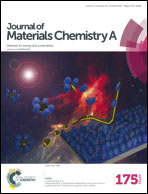Porous nanoMoC@graphite shell derived from a MOFs-directed strategy: an efficient electrocatalyst for the hydrogen evolution reaction†
Abstract
The hydrogen evolution reaction using noble-metal free electrocatalysts has captured increasing attention due to its importance in renewable hydrogen production. Herein, a highly active and stable electrocatalyst of MoC encapsulated by graphitized carbon shells (nanoMoC@GS) has been developed via an in situ carburization of a Mo-based metal–organic framework (Mo-MOF) with the atomic periodic structure. The ultrafine MoC nanoparticles (∼3 nm) confined by 1–3 layered graphite shells significantly favor the efficient HER in both acidic and basic media. In particular, a low overpotential (η10 = 124 and 77 mV at a current density of −10 mA cm−2), a small Tafel slope (43 and 50 mV dec−1) and a high exchange current density (j0 = 0.015 and 0.212 mA cm−2) are achieved on nanoMoC@GS in 0.5 M H2SO4 and 1.0 M KOH, respectively. Such remarkable activity, outperforming most current noble-metal-free electrocatalysts, stems from the cooperative/synergistic effects of ultrafine MoC nanostructure, ultrathin and conductive graphitized carbon shells, and enriched porosity. This work demonstrates a feasible way to design high-performance electrocatalysts via converting “atomic contact” hybrid structures (e.g., MOFs), illustrating a new perspective for developing nanocatalysts in the energy chemistry field.



 Please wait while we load your content...
Please wait while we load your content...